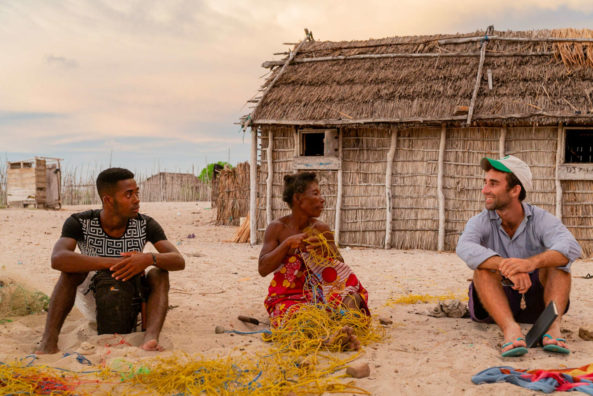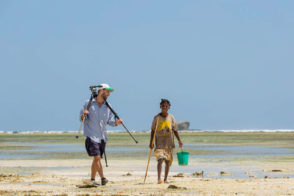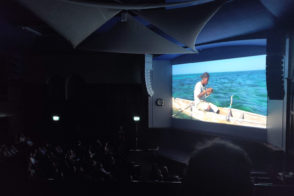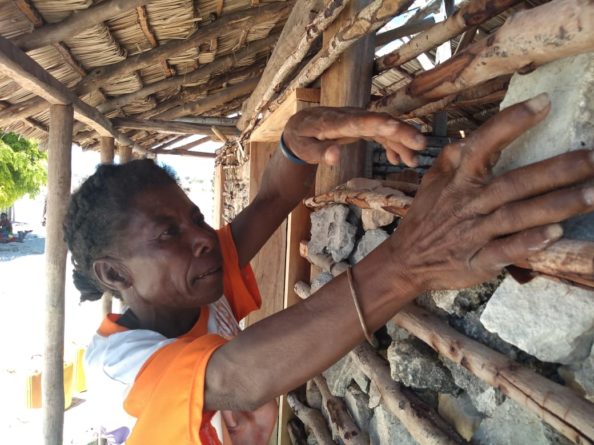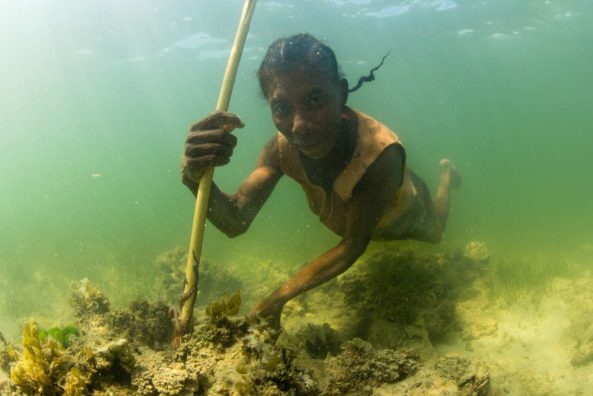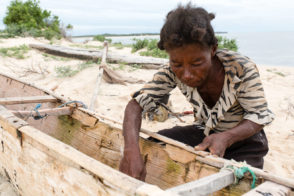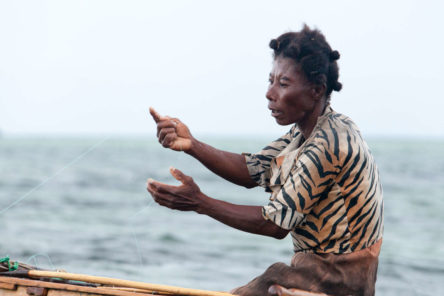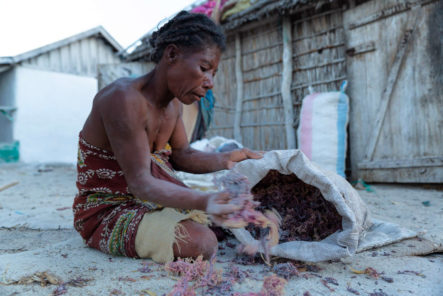After travelling around 15 kilometres south of Andavadoaka, southwest Madagascar, I arrived in Kokoly’s village to see her out in the water, gleaning for sea cucumbers. The water was too shallow to take a boat, so I decided to wade across the water to see her. As soon as she saw me, she said, “Where have you been, Paul?” I told her I had been in Andavadoaka, where I’m based for work, and she said, “Well, you must not be very popular anymore!”, to which I responded, “Well you certainly are!”.
Madame Kokoly, while diminutive in physical stature, commands a towering presence amongst her community. Her skills as an octopus gleaner are well-respected and her tendency to seemingly work all hours of the day make her a local curiorisity. Now, thanks to a Sundance Institute film, she has gone global.
In late 2016, I spent four months capturing Kokoly’s life living off the ocean. I was joined by my fellow Blue Ventures colleagues Solontena, Emilienne and Garth, as well as Avy, a Vezo fisherman from Andavadoaka. We paddled to the edge of reefs to watch her glean, walked kilometers into dense mangrove forests to observe her gathering building materials and sailed under the blistering sun to see her line-fishing. As we spoke with her at the end of each day, we would hear the same stories of decline;
…What used to be so plentiful now you can’t find anymore, like turtles or trevallies, there aren’t any. It was better, but now everything’s worth so much. It’s terrible, it makes me really sad. Everything’s difficult to find, what’s left is hiding far away, because they’re scared…”
This decline in natural marine resources observed by Kokoly, is mirrored across Madagascar and the wider coastal tropics. On the global stage, the triggers for this loss such as overfishing and climate change are widely discussed, yet the perspectives of small-scale fishers like Kokoly are often overlooked. That’s why Kokoly has struck such a chord across the world.
Other small-scale fishing communities we have shown the film to have connected with Madame Kokoly’s way of life, but also recognise in her words their own experiences of a changing ocean environment. For audiences in Europe and America, the film has provided a glimpse into a way of living that on the surface feels far removed, but in reality is deeply connected to their choices as consumers.
Back in the village, it was great to catch up with Kokoly and her community, it was like being reunited with familyBack in the village, it was great to catch up with Kokoly and her community, it was like being reunited with family. I noticed quite a lot of changes in the village since my last visit – the open area, shaded by a large Nim tree where we would film Kokoly and her family, is now being encroached upon by houses. Kokoly’s house which used to stand on its own in the middle of the open courtyard (and looks quite big in the film!), is dwarfed by the new houses that have been built. Nevertheless, it was heartening to see that the family still seems to spend most of their time gathered under the shade of the tree, in the heart of the village.
It was no surprise to see that Kokoly is still Kokoly, doing what she always does – getting up, moving around, doing this and that, chopping wood, playing with babies, corralling ducks into their fence, picking through people’s hair for lice, cooking, continuing to build various houses…
Her proactive, energetic nature never seems to subside, but after hearing her stories of resource decline over the years, I am all too aware that there is often a challenging backdrop to her unwavering perseverance.
I ask about how the ocean is treating her and she tells me she’s struggling, that there are fewer and fewer octopus. Her niece, who is sitting with us, says she thinks there are too many people who rely on octopus fishing in the village, and life is getting “cramped”. Her mother also told me that Kokoly’s boat is leaking, which means that she is struggling to go out line-fishing – an alternative to gleaning for octopus.
Walking through the village, I notice some octopus in a bucket that have just been caught. But it’s a neap tide (when the difference between low and high tide is minimal, so the reef is mostly underwater) which means that only men in the village will have been able to catch them as they tend to be the most able divers.
Octopus fishing has become more of a men’s livelihood in the village; not that this would deter Madame Kokoly. As we hear her friend and fellow fisherwoman say in the film, Kokoly is thought to be “the man of the house” – she goes fishing and hunting, and provides physically for her family. Whilst comments about her non-stereotypical behaviour sometimes seem to be veiled mockery, by and large it’s clear that she inspires and awes those around her.
Kokoly doesn’t stop [working] because she is the man of the house, making a living. But the rest of us, our husbands are fishermen, we can afford to rest… but if Kokoly doesn’t go out she’ll be thinking to herself ‘what will we eat today?’”
I told Kokoly and her family that I had come to show them the final film, and shared the news about it being shown all around the world; that audiences had been encouraged, inspired and amazed by her and her story.
We crammed into a half finished house (which Kokoly has had a hand in building – of course!) and watched the film twice in a row. We invited everyone who was in the film to join us; they watched intently, laughing affectionately at Kokoly’s sayings, like, “God didn’t make me to sleep during the day!”
After the first showing was over, Kokoly’s mother turned to me and said, “This is a true story, it’s all true”Even though her friends and family know Kokoly and all she can do, it seemed that they were almost surprised to see her building a pirogue and building her house in the film – things that women don’t normally do. After the first showing was over, Kokoly’s mother turned to me and said, “This is a true story, it’s all true”.
In the beginning, when Garth and I spoke to the family about our idea for the film, Kokoly’s main concern was that the people in her village would make fun of her. We assured her that the film wasn’t for a local audience, which she was relieved about. After watching the finished film, almost three years later, I brought this back up and asked if it would be okay for us to show the film around nearby villages. Kokoly smiled and nodded, and her mother agreed, “You have to, people should see this and know her story”.
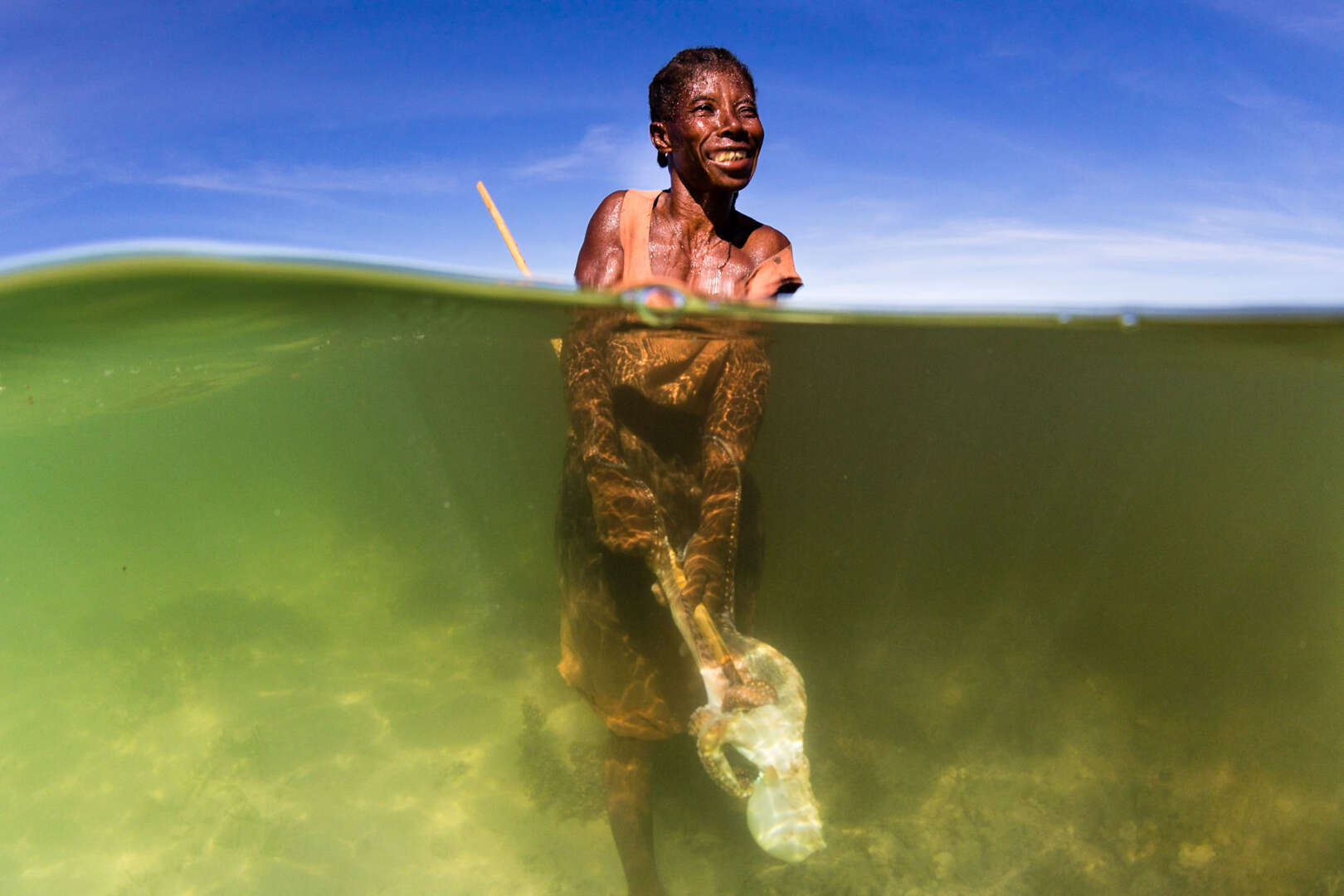
Kokoly’s infectious smile | Photo: Garth Cripps
Kokoly’s new peers include the giants of natural history filmmaking, such as the BBC and National GeographicKokoly has now been screened at ten film festivals across the world, including the prestigious Jackson Wild Film Festival and the International Ocean Film Festival. Kokoly’s new peers include the giants of natural history filmmaking, such as the BBC and National Geographic.
When I asked how she feels about her film being seen by so many people all over the world, she said, “I’m happy. It’s like I’ve made it abroad, but I didn’t have to go myself!”, you see, Kokoly is frightened of all motorised transport.
The family joked that Kokoly should go abroad to these festivals, to which she said, “No way, you’re not getting me in a car!” I joked along with them, saying that we should build a pirogue so that she could tour her film around the world. Kokoly didn’t seem convinced, “I’m going to stay here in my village”, she asserted, “but you can film me as much as you want!”
Read about the making of the film in Oceanographic magazine’s article, Kokoly: fishing for a future
Watch the full film below or visit kokolyfilm.com
A special thanks to…
Madame Kokoly, her family, and the men and women of Velondriake
The Velondriake Committee
Sundance Institute and the Skoll Foundation
Garth Cripps, Matthew Judge, Solontena Raivosoa, Emilienne Razanadrasoa, Avy, Ruth Leeney, Martin Muir, Jerry Rothwell, Adam Lavis


